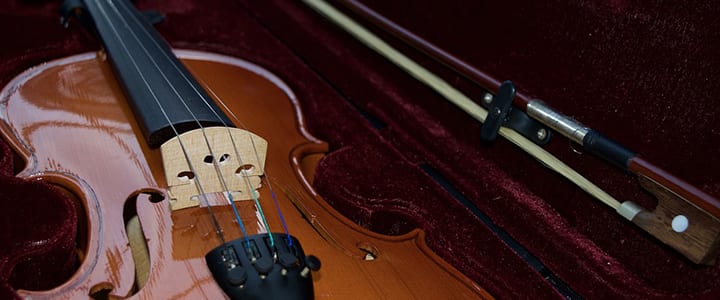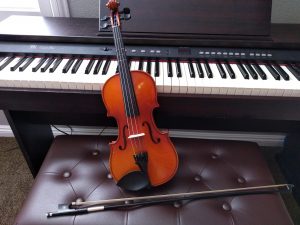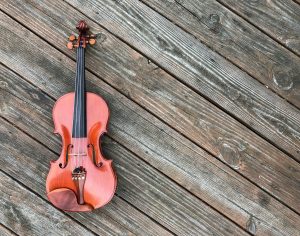
How long does it take to learn violin? Unfortunately, the answer isn’t as cut and dry as it might seem.
After all, wouldn’t it be great to learn to play an instrument in minutes? Think of the musical repertoire you would have! Unfortunately, like many different skill sets, that simply isn’t the case. Learning to play an instrument, as with driving and hitting a great shot on the golf course, is all about practice. The more you practice, the faster you learn, and the better you play. And the violin, a wooden chordophone with a beautiful soprano sound, takes time to learn, just like any other instrument.
Whether you want to learn to play the violin for something to do in your spare time or to join a string band, or a little of both, your learning speed depends on how much you practice! If you would like to play the violin professionally, commitment to many years of hard work is essential.
So, exactly how long does it take to learn violin? Well, the answer is entirely up to you. With a continuous and steady training schedule, you can make a lot of progress toward your goals in three to five years. Keep reading for more details on how to learn the violin.
Is It Hard to Learn the Violin? 
When it comes to the question of how long does it take to learn violin basics, it’s ultimately not very difficult at all. The challenge arises when you are trying to learn how to play the violin well. It takes some practice to master this challenging instrument!
That said, you can improve your odds of becoming a skilled violinist by:
- Learning music theory
- Doing a warm-up every time you play
- Using violin tabs for learning sheet music
- Being patient!
Can I Teach Myself Violin? 10 Steps to Take
How long does it take to learn violin for adults? The answer varies, but in general, you’ll have the most success if you follow these 10 simple steps – and basic timeline.
1. Selecting Your Instrument and Style of Learning
Before diving headfirst into your new-found passion of learning to play the violin, the most important step in this process is selecting a violin that’s a perfect fit for you. You’re going to want one that looks good, feels good against your shoulder, and above all, sounds good. Don’t settle for the first fiddle you come across in the music shop because choosing a bad instrument can be detrimental to your development as a player.
Whether you want to rent a violin during the early phases of your learning process, buy a used one, or go all-in on a brand new instrument, it’s important to research what will work best for you. Check out our list of the best violin brands for beginners.
One common question for many violin students is: how long does it take to learn violin? If you take violin lessons and practice four to five days a week, here is an estimated timeline to illustrate how long it takes to learn the violin.
You’ll also want to decide how you plan on learning the violin. When it comes to addressing the question of how long does it take to learn violin well, you’ll find that you can learn how to play much easier if you have a skilled teacher showing you the ropes.
Of course, you can also teach yourself violin by reading books and watching tutorials on the subject. Here’s one video that can help get you up and running as you learn violin:
2. Month One
If you’re trying to learn a second language, you always start with the basics, like the alphabet, numbers, and easy words and phrases. Learning the violin is no different. In your first month, you’ll start with the fundamentals, like learning the parts of your violin and about proper care.
Doing something new can feel weird and unnatural, but that’s normal. Don’t be afraid to play your violin because you’re just starting. Embrace the fact that mistakes will be made and corrected over time.
Your early lessons will focus on posture, bow hold, and plucking techniques, as well as basic note reading, violin scales, and music theory. You’ll also find out how to pluck, bow open strings, and learn about quarter notes and quarter rests before moving onto simple tunes and exercises that will help you throughout this learning process.
3. Month Two
This month, you’ll continue to develop basic skills, and become more comfortable holding your instrument and bow.
At this time, you should start using your left-hand fingers (1-3) to play notes other than open strings. You’ll develop the ability to pluck simple melodies and gain greater control bowing open strings.
You’ll also find out about bow directions and markings (up bows and down bows) and learn about half notes and half rests.
4. Month Three to Six
These months are exciting because you’ll start to play some simple songs you recognize.
You’ll learn lots of new notes, including the notes on the D and A strings using fingers one, two, and three.
Gradually, you’ll switch to using your bow to play songs instead of just plucking them. Some new rhythms will be whole notes, whole rests, eighth notes, and eighth rests.
5. Month Seven to 12
At this point, the range of songs you can play really opens up because you know so many notes and rhythms!
You’ll discover how to use your fourth finger and some notes on the G and E strings and find out ways to use your second finger to play F natural and C natural on the D and A strings.
By the end of month six, you’ll continue developing your bowing technique. As your violin tone starts to improve, you will learn about slurs and hooked bowing, as well as how to cross strings more proficiently. You’ll also learn the difference between staccato and legato bowing.
New rhythms that will be picked up are ties and dotted half notes.
6. Month 13 to 18
At this point in your journey toward learning to play the violin, you’ve probably finished your first beginner lesson book and have moved on to the next book in the series. Now, you can play many pop, classical, folk, and holiday songs. You may still need help figuring them out, but with some practice, you can play lots of different songs.
Keep progressing by learning about more natural and flat notes with all four of your fingers, which allows you to play in keys other than D and A major.
Slurs and hooked bows are common in your music, and you’re able to coordinate the bow with your fingers. You can play faster music without losing your tone quality. You’ll also learn about dotted quarter notes and syncopation.
7. Month 19 to 24
By month 19, you can really branch out into music you like to play. You might start learning basic classical solos meant to be performed with piano accompaniment or get a book of music from your favorite movie or pop singer.
You’ll learn all of the notes you can play in first position, including sharps, naturals, and flats, and you’ll learn how to bounce the bow and play faster with more accuracy.
Rhythms you’ll learn at this point are sixth notes and dotted eighth notes.
8. Year Three
This might be the time you start to feel like you can really play the violin!
In your third year, you’ll solidify all the notes in first position, and become comfortable playing in flat keys. Your bowing will become more complex and varied, and you’ll begin to grasp double stops and triplets.
9. Year Four
If you’ve made it this far, congratulations, you’re pretty dedicated to the violin, and by now, you’re pretty good!
Now it’s time to learn about shifting into third position, which opens up the range of the violin, so you can play higher notes.
You might also want to learn how to play with vibrato, which will give you a more sophisticated sound and greater range of musical expression.
How long does it take to learn vibrato on violin? Some beginners start playing around with vibrato right out of the gate, but you won’t become a pro until you’ve got a few years of experience under your belt.
You probably don’t need a beginner lesson book series anymore, and you can further your learning by working in scale, etude, and solo repertoire books.
10. Year Five and Beyond
The sky’s the limit for what you can learn and where you can go. The more time you dedicate to practicing the violin, the faster you can increase your skills and learn more music you love to play.
If you practice hard and stay dedicated to learning the violin, you can make a lot of progress in just a few years.
How long it takes to learn violin depends on your individual goals and how far you want to go. To stay motivated, keep this map where you can see it, so you can always have your goals in sight.

How Long Does it Actually Take to Learn Violin?
How long it takes to learn violin depends on your individual goals and how far you want to go. To stay motivated, keep this map where you can see it, so you can always have your goals in sight.
The truth is, everyone learns at a different speed, so there’s no way to tell exactly how long it will take you to learn the violin.
How long does it take to learn a violin concerto? Give yourself at least a few months (but ideally a year) to do this. You can move on to more complicated pieces soon after that.
Overall, the best way to learn the violin quickly is through private lessons with a qualified instructor. Click here to find a violin teacher near you. Or sign up for online violin lessons and learn from the comfort of your own home!
How long did it take you to learn to play the violin? Let us know in a comment below!
 Post Author: Julie P.
Post Author: Julie P.Julie P. is a music teacher in Brooklyn, NY. She received her Bachelor’s degree in Music Education from Ithaca College and her Masters in Music Performance from New Jersey City University. Learn more about Julie here!
Maile Proctor
![How Long Does It Take To Learn Violin? [Infographic]](/_next/image?url=https%3A%2F%2Ftakelessons.com%2Fblog%2Fwp-content%2Fuploads%2F2016%2F03%2Fhow-long-does-it-take-to-learn-violin-feature.jpg&w=3840&q=75)